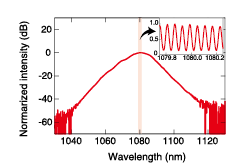15-GHz Optical Frequency Comb as Calibration Source for Astronomical Spectrographs
Kobayashi Group
Optical frequency comb (OFC), based on a frequency-stabilized femtosecond mode-locked pulsed laser, have become an invaluable tool in precision applications, including optical clocks, frequency metrology and spectroscopy. Our group are developing OFCs and studying precision spectroscopies with OFC. Here, we highlight a 15-GHz OFC as a calibration source for astronomical spectrographs.

Fig. 1. Layout of the 15-GHz laser.

Fig. 2. Optical spectra measured with an optical spectrum analyzer at a resolution of 2 nm and (inset) 16 pm.
In astronomy one of the main research topics is searching for Extra-solar planets. Extra-solar planets are detected by a Doppler shift of the absorption spectrum of the fixed star with a carefully-calibrated spectrograph, and then, one can derive the information about the planets, for example its revolution period, distance from the host star and its weight. In order to detect an Earth-like planet around a Sun-like fixed star, the spectrograph needs the calibration level within a velocity of 10 cm/s, corresponding to the wavelength shift of 0.3 femtometer at the center wavelength of 1000 nm, as a Doppler shift during more than one year, which is extremely-difficult task. Although usually I2 cell or Th-Ar lamp have been used for a conventional calibration sources, they do not satisfy the long-term stability, traceability and the spectral cover range. OFC is one of the alternatives to concur such drawbacks. It is because that OFC emits a broadband comb-like spectrum and the longitudinal modes are evenly spaced by a separation equal to the pulse repetition rate. That is, OFC is an ideal “frequency scale” for spectrographs.
Conventional OFCs, however, cannot be used for a frequency scale. Typically, mode separation is less than the resolution of spectrograph, several hundred MHz and GHz respectively — imagine a ruler with too dense scales to be resolved by your eyes. The mode spacing of 10 to 20 GHz, hundred times higher than that of typical OFCs, is required. One of the methods to obtain such large mode spacing is using several Fabry–Pérot cavities as harmonic mode filters. This scheme, however, significantly increases apparatus complexity and cannot perfectly suppress the unwanted adjacent modes. In our group, an OFC with a mode spacing of 15 GHz has been developed based on a 15-GHz femtosecond laser [1]. This OFC directly produce a comb-like spectrum with sufficiently large mode spacing to be resolved by a conventional spectrograph and it would be a suitable calibration source. Figure 1 shows the 15-GHz femtosecond laser. The laser composed four-mirror ring cavity with a cavity length of only 2 cm, as so far this is the shortest cavity length in femtosecond Kerr-lens mode-locked lasers. The gain material was an ytterbium-doped Y2O3 ceramic and the laser emitted a pulse with a pulse duration of 152 fs and an average power of 60 mW. The optical spectrum is shown in Fig. 2. Thanks to sufficiently high repetition rate, a commercial spectrometer could resolve comb structure. One of the longitudinal modes of the 15-GHz laser was phase locked to an optical frequency standard, semiconductor laser locked to an ultra-low expansion glass cavity with a frequency drift of less than 0.5 MHz/month. Furthermore our laser was pumped by a reliable semiconductor laser diode, which was suitable for long-term operation.
In this report, we especially focused on a calibration source of spectrograph as a 15-GHz OFC application. The reported 15-GHz OFC also has a potential to expand the comb applications, including optical arbitrary waveform generation, low-phase noise microwave generation.
References
- [1] M. Endo, I. Ito, and Y. Kobayashi, Opt. Express 23, 10564 (2015).
